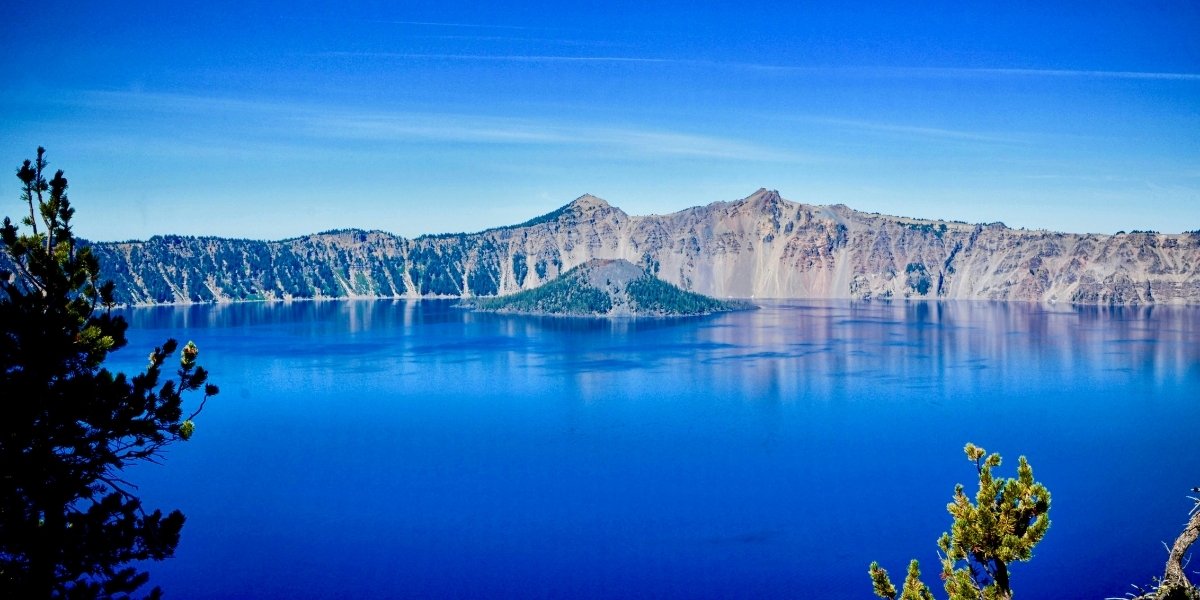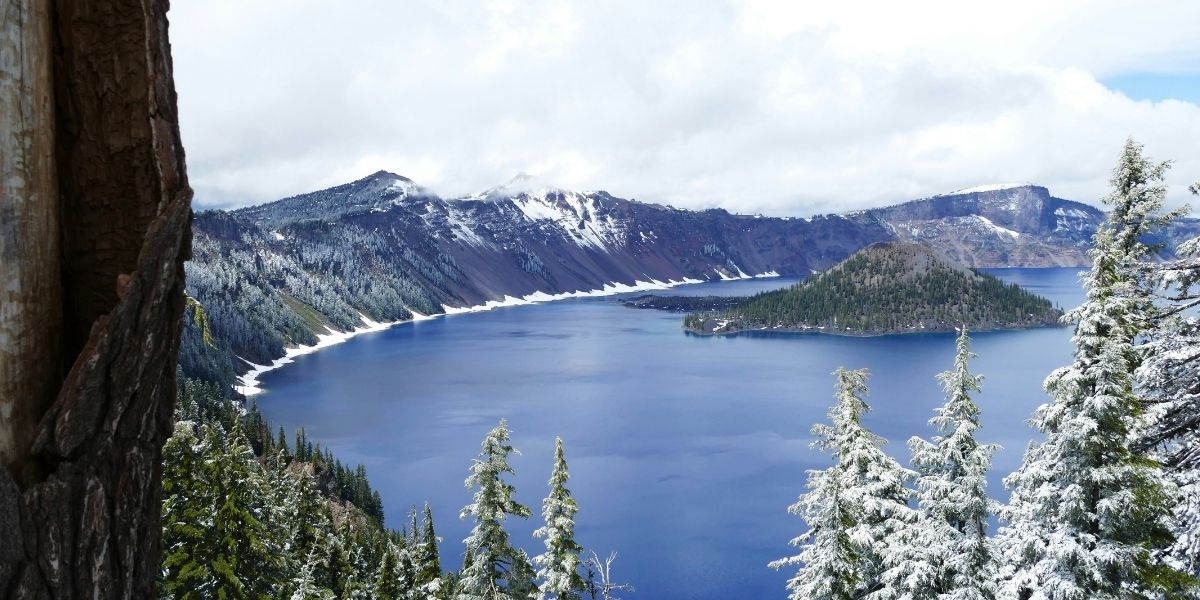Crater Lake, nestled in the Cascade Mountains of southern Oregon, is a natural wonder renowned for its stunning deep blue color and incredible clarity. This magnificent body of water is not merely a lake; it is the deepest lake in the United States, representing a remarkable geological phenomenon. Its pristine waters fill a caldera, a massive basin formed thousands of years ago after the collapse of an ancient volcano. The sheer scale of its formation and its untouched beauty draw visitors from around the globe, eager to witness its captivating allure and understand its unique natural history.
The very essence of Crater Lake lies in its dramatic origin. Unlike typical lakes formed by rivers or glaciers, this lake is the direct result of a cataclysmic volcanic eruption followed by the subsequent collapse of the mountain peak. This violent geological event left behind a deep, bowl-shaped depression that gradually filled with rainwater and snowmelt over centuries, creating the isolated and remarkably pure body of water seen today. The absence of inlets from rivers or streams means that its water quality is exceptionally high, contributing to its famed transparency and intense color.
Read Also: Discover Tennessee’s Unique Wildlife and Nature Reserves
A visit to Crater Lake offers more than just scenic views; it provides a profound connection to powerful natural forces that shaped the Earth. The surrounding national park safeguards this unique ecosystem, preserving its geological features, diverse wildlife, and the serene environment that envelops the lake. Exploring its rim, observing its unique islands, or simply gazing into its depths can evoke a sense of awe at the power and artistry of nature. Crater Lake remains a pristine example of an untouched wilderness, inviting contemplation and appreciation for its singular beauty.
How Was Crater Lake Formed Through Volcanic Activity?
The formation of Crater Lake is a dramatic geological story, beginning with a towering ancient volcano known as Mount Mazama. For hundreds of thousands of years, this majestic stratovolcano grew through successive eruptions, eventually reaching an estimated height of 12,000 feet. Like many active volcanoes, Mount Mazama experienced periods of both quiet and explosive activity. Its peak contributed to the dramatic mountain range, dominating the landscape long before the lake we know today came into existence. The geological processes at play built a massive edifice, setting the stage for a truly extraordinary event.
Approximately 7,700 years ago, Mount Mazama underwent a colossal eruption, one of the most powerful in North American history. This cataclysmic event expelled an enormous volume of ash and pumice, blanketing vast areas of the Pacific Northwest. As the volcano emptied its magma chamber, the unsupported summit of the mountain could no longer sustain its own weight. The peak then violently collapsed inward, creating a massive caldera over 5 miles in diameter and nearly 4,000 feet deep. This enormous depression was the foundational step in the creation of Crater Lake, as it formed the basin that would eventually hold the pristine waters.

Photo Credit: Unsplash.com
Following the collapse, centuries of rainfall and snowmelt gradually filled the caldera, forming the deep lake. Because there are no incoming rivers or streams to carry sediment, the water in Crater Lake is exceptionally pure, contributing to its famous clarity and intense blue hue. Over time, further volcanic activity within the caldera formed cinder cones, with Wizard Island being the most prominent example, standing proudly in the lake today. The geological forces that shaped Crater Lake were immense, leaving behind a remarkable natural monument that continues to captivate those who visit.
What Makes Crater Lake So Exceptionally Deep and Clear?
The extraordinary depth is directly attributed to its volcanic origin, specifically the violent collapse of Mount Mazama. The caldera formed after the eruption created a remarkably deep, bowl-shaped depression. This natural basin, with its steep, inward-sloping walls, acts as a massive container for water. Over millennia, snowmelt and rainfall accumulated in this enclosed basin, eventually filling it to its current impressive depth. This unique geological structure, combined with centuries of water accumulation, makes Crater Lake the deepest lake in the United States, reaching nearly 1,943 feet at its deepest point.
The exceptional clarity is primarily due to its hydrological isolation. Unlike most lakes, Crater Lake has no surface inlets or outlets in the form of rivers or streams. This means that its water sources are exclusively precipitation – rainfall and snowfall – which are inherently pure. The absence of incoming streams prevents the introduction of sediment, silt, and pollutants that would typically reduce water clarity in other lakes. Without these external inputs, the suspended particles in the water are minimal, allowing sunlight to penetrate to remarkable depths, contributing to its famous transparency.
The deep blue color is also a direct consequence of its depth and clarity. Water naturally absorbs longer wavelengths of light (like reds, yellows, and greens) and scatters shorter wavelengths (like blues and violets). Because the water in Crater Lake is so deep and clear, there are very few particles to reflect light back. This allows the blue light to penetrate deeply and then scatter, creating the intense, vibrant blue hue that is characteristic of the lake. The combination of its profound depth, pristine purity, and the physics of light makes Crater Lake a truly mesmerizing body of water, offering unparalleled visual splendor.
What Unique Features Can Be Found Within Crater Lake?
Crater Lake is home to several unique geological features that add to its mystique and scientific interest. The most prominent of these is Wizard Island, a perfectly conical cinder cone rising majestically from the western part of the lake. Formed by post-caldera volcanic eruptions, Wizard Island stands as a miniature volcano within the larger caldera, offering a tangible link to the fiery past of Mount Mazama. Visitors can hike to its summit, providing a unique perspective of the surrounding Crater Lake and the vast caldera rim, truly immersing them in the volcanic landscape.

Photo Credit: Unsplash.com
Another intriguing feature within Crater Lake is the Phantom Ship, a small, natural rock formation resembling a ghostly sailing ship. This island is composed of ancient lava flows that predate the caldera-forming eruption, making it a geological remnant of Mount Mazama’s original structure. Its jagged pinnacles and dark color often cause it to appear and disappear in the mist or changing light conditions, giving it its evocative name. The Phantom Ship adds a touch of mystery to the already captivating scenery, providing a striking contrast to the deep blue waters of Crater Lake.
Beyond the islands, the “Old Man of the Lake” is a peculiar and enduring phenomenon within Crater Lake. This is a full-sized, ancient tree trunk, remarkably well-preserved due to the lake’s cold, deep waters. It has been floating vertically in the lake for over a century, drifting slowly across its surface. The top of the log usually extends a few feet above the waterline, while the bulk of its mass remains submerged. Its continued presence and unique movement make it a fascinating natural curiosity, highlighting the exceptional preservation qualities of Crater Lake’s depths and adding to its legendary charm.
How Are Conservation Efforts Protecting Crater Lake’s Purity?
Conservation efforts at Crater Lake National Park are meticulously designed to protect its extraordinary purity and pristine environment for future generations. Given that the lake’s water quality is directly dependent on precipitation and the absence of external contaminants, park management implements strict regulations to prevent pollution. This includes managing visitor access, restricting certain types of watercraft, and educating the public on responsible recreation. The goal is to maintain the delicate balance of the lake’s ecosystem, ensuring its renowned clarity and deep blue color remain untainted by human activity.
Read Also: Hendersonville Spring Events and Lakefront Activities Guide
Scientific research plays a crucial role in these conservation efforts. Limnologists, geologists, and biologists regularly monitor Crater Lake‘s water quality, temperature, and biological indicators to detect any changes or threats to its delicate balance. Studies on the lake’s unique aquatic life, including its native fish populations and microscopic organisms, help park officials understand the health of the ecosystem and adapt management strategies as needed. This ongoing scientific oversight provides the necessary data to make informed decisions that safeguard Crater Lake from both immediate and long-term environmental challenges, ensuring its long-term preservation.
Public education and engagement are integral components of Crater Lake’s conservation strategy. The park provides extensive interpretive programs, ranger-led talks, and informational materials that highlight the lake‘s unique geological history, ecological significance, and the importance of responsible stewardship. By fostering a deeper appreciation for this natural wonder, these programs encourage visitors to participate in its protection. Collective efforts, from individuals adhering to park rules to large-scale scientific initiatives, contribute to the ongoing preservation of Crater Lake’s pristine beauty and unique status as a natural treasure.








